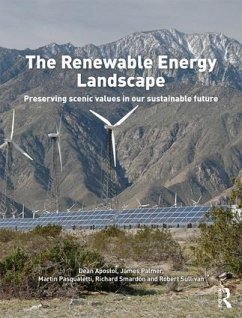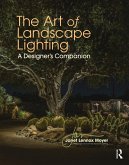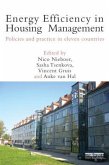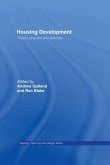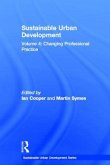The Renewable Energy Landscape
Preserving Scenic Values in Our Sustainable Future
Herausgeber: Apostol, Dean; Sullivan, Robert; Smardon, Richard; Pasqualetti, Martin; Palmer, James
The Renewable Energy Landscape
Preserving Scenic Values in Our Sustainable Future
Herausgeber: Apostol, Dean; Sullivan, Robert; Smardon, Richard; Pasqualetti, Martin; Palmer, James
- Gebundenes Buch
- Merkliste
- Auf die Merkliste
- Bewerten Bewerten
- Teilen
- Produkt teilen
- Produkterinnerung
- Produkterinnerung
This book forms a new framework for analyzing, describing, and conserving scenic resources in the face of mounting pressures to develop renewable energy projects.
Andere Kunden interessierten sich auch für
![The Art of Landscape Lighting The Art of Landscape Lighting]() Janet Lennox MoyerThe Art of Landscape Lighting189,99 €
Janet Lennox MoyerThe Art of Landscape Lighting189,99 €![Housing Design Quality Housing Design Quality]() Matthew CarmonaHousing Design Quality187,99 €
Matthew CarmonaHousing Design Quality187,99 €![Energy Efficiency in Housing Management Energy Efficiency in Housing Management]() Energy Efficiency in Housing Management179,99 €
Energy Efficiency in Housing Management179,99 €![Kitchen Table Sustainability Kitchen Table Sustainability]() Wendy SarkissianKitchen Table Sustainability181,99 €
Wendy SarkissianKitchen Table Sustainability181,99 €![Housing Development Housing Development]() Andrew Golland (ed.)Housing Development160,99 €
Andrew Golland (ed.)Housing Development160,99 €![Sustainable Urban Development Volume 4 Sustainable Urban Development Volume 4]() Ian Cooper / Martin Symes (eds.)Sustainable Urban Development Volume 4149,99 €
Ian Cooper / Martin Symes (eds.)Sustainable Urban Development Volume 4149,99 €![Housing, Care and Inheritance Housing, Care and Inheritance]() Misa IzuharaHousing, Care and Inheritance129,99 €
Misa IzuharaHousing, Care and Inheritance129,99 €-
-
-
This book forms a new framework for analyzing, describing, and conserving scenic resources in the face of mounting pressures to develop renewable energy projects.
Hinweis: Dieser Artikel kann nur an eine deutsche Lieferadresse ausgeliefert werden.
Hinweis: Dieser Artikel kann nur an eine deutsche Lieferadresse ausgeliefert werden.
Produktdetails
- Produktdetails
- Verlag: Taylor & Francis
- Seitenzahl: 342
- Erscheinungstermin: 26. August 2016
- Englisch
- Abmessung: 249mm x 193mm x 23mm
- Gewicht: 998g
- ISBN-13: 9781138808980
- ISBN-10: 1138808989
- Artikelnr.: 41852719
- Herstellerkennzeichnung
- Libri GmbH
- Europaallee 1
- 36244 Bad Hersfeld
- gpsr@libri.de
- Verlag: Taylor & Francis
- Seitenzahl: 342
- Erscheinungstermin: 26. August 2016
- Englisch
- Abmessung: 249mm x 193mm x 23mm
- Gewicht: 998g
- ISBN-13: 9781138808980
- ISBN-10: 1138808989
- Artikelnr.: 41852719
- Herstellerkennzeichnung
- Libri GmbH
- Europaallee 1
- 36244 Bad Hersfeld
- gpsr@libri.de
Dean Apostol is Senior Landscape Architect and Restoration Ecologist for MIG Inc, a consulting firm with offices in California, Oregon and Colorado, USA. He researches, consults, and does environmental analysis on energy projects and aesthetic impacts. James Palmer has had a distinguished professional career in landscape architecture spanning thirty-five years, focusing on the assessment of landscape character and aesthetic quality. Through publications, peer reviews, court expert testimony, and teaching, he has raised the standards in the field. He frequently consults on wind energy aesthetic impacts in the Northeast. Martin Pasqualetti is Professor in the School of Geographical Sciences and Urban Planning at Arizona State University, USA, and a Senior Sustainability Scientist in the Julie Ann Wrigley Global Institute of Sustainability. For over forty years, he has been examining the relationships between energy and environment, especially the formation and mitigation of renewable energy landscapes. Richard Smardon is a SUNY Distinguished Service Professor Emeritus at the SUNY College of Environmental Science and Forestry in Syracuse, New York, USA, and has over thirty-five years of experience with visual impact assessment methodology development, twenty years of project management, and has testified in over fifteen cases with visual impact assessment issues. Robert Sullivan is an environmental scientist in Argonne National Laboratory's Environmental Science Division, USA. He conducts research on the visual impacts of fossil fuel and renewable energy systems, and develops guidance documents for federal agencies on visual resource inventory, management, and protection.
1. The Changing Landscapes of Renewable Energy (Dean Apostol
Richard Smardon
Robert Sullivan
James Palmer and Martin Pasqualetti)
Part I
2. Conserving Scenery During an Energy Transition (Martin Pasqualetti and Richard Smardon)
3. Managing New Energy Landscapes in the USA
Canada
and Australia (Richard Smardon
Ian Bishop and Robert Ribe)
4. Adjusting to Renewable Energy in a Crowded Europe (Simon Bell)
5. Social Acceptance of Renewable Energy Landscapes (Richard Smardon and Martin J. Pasqualetti)
Part II
6. The Visual Signatures of Renewable Energy Projects (Robert Sullivan)
7. Improving the Visual Fit of RE Projects (Dean Apostol
John McCarty
and Robert Sullivan)
8. Measuring Scenic Impacts of Renewable Energy Projects (Louise Kling
James Palmer
and Richard Smardon)
9. Visualizing Proposed Renewable Energy Projects (Robert Sullivan)
10. Engaging Communities in Creating New Energy Landscapes (Richard Smardon and James Palmer)
11. Policy Recommendations for the New Energy Landscape ( Dean Apostol
Richard Smardon
James Palmer
Martin Pasqualetti and Robert Sullivan)
Richard Smardon
Robert Sullivan
James Palmer and Martin Pasqualetti)
Part I
2. Conserving Scenery During an Energy Transition (Martin Pasqualetti and Richard Smardon)
3. Managing New Energy Landscapes in the USA
Canada
and Australia (Richard Smardon
Ian Bishop and Robert Ribe)
4. Adjusting to Renewable Energy in a Crowded Europe (Simon Bell)
5. Social Acceptance of Renewable Energy Landscapes (Richard Smardon and Martin J. Pasqualetti)
Part II
6. The Visual Signatures of Renewable Energy Projects (Robert Sullivan)
7. Improving the Visual Fit of RE Projects (Dean Apostol
John McCarty
and Robert Sullivan)
8. Measuring Scenic Impacts of Renewable Energy Projects (Louise Kling
James Palmer
and Richard Smardon)
9. Visualizing Proposed Renewable Energy Projects (Robert Sullivan)
10. Engaging Communities in Creating New Energy Landscapes (Richard Smardon and James Palmer)
11. Policy Recommendations for the New Energy Landscape ( Dean Apostol
Richard Smardon
James Palmer
Martin Pasqualetti and Robert Sullivan)
1. The Changing Landscapes of Renewable Energy (Dean Apostol
Richard Smardon
Robert Sullivan
James Palmer and Martin Pasqualetti)
Part I
2. Conserving Scenery During an Energy Transition (Martin Pasqualetti and Richard Smardon)
3. Managing New Energy Landscapes in the USA
Canada
and Australia (Richard Smardon
Ian Bishop and Robert Ribe)
4. Adjusting to Renewable Energy in a Crowded Europe (Simon Bell)
5. Social Acceptance of Renewable Energy Landscapes (Richard Smardon and Martin J. Pasqualetti)
Part II
6. The Visual Signatures of Renewable Energy Projects (Robert Sullivan)
7. Improving the Visual Fit of RE Projects (Dean Apostol
John McCarty
and Robert Sullivan)
8. Measuring Scenic Impacts of Renewable Energy Projects (Louise Kling
James Palmer
and Richard Smardon)
9. Visualizing Proposed Renewable Energy Projects (Robert Sullivan)
10. Engaging Communities in Creating New Energy Landscapes (Richard Smardon and James Palmer)
11. Policy Recommendations for the New Energy Landscape ( Dean Apostol
Richard Smardon
James Palmer
Martin Pasqualetti and Robert Sullivan)
Richard Smardon
Robert Sullivan
James Palmer and Martin Pasqualetti)
Part I
2. Conserving Scenery During an Energy Transition (Martin Pasqualetti and Richard Smardon)
3. Managing New Energy Landscapes in the USA
Canada
and Australia (Richard Smardon
Ian Bishop and Robert Ribe)
4. Adjusting to Renewable Energy in a Crowded Europe (Simon Bell)
5. Social Acceptance of Renewable Energy Landscapes (Richard Smardon and Martin J. Pasqualetti)
Part II
6. The Visual Signatures of Renewable Energy Projects (Robert Sullivan)
7. Improving the Visual Fit of RE Projects (Dean Apostol
John McCarty
and Robert Sullivan)
8. Measuring Scenic Impacts of Renewable Energy Projects (Louise Kling
James Palmer
and Richard Smardon)
9. Visualizing Proposed Renewable Energy Projects (Robert Sullivan)
10. Engaging Communities in Creating New Energy Landscapes (Richard Smardon and James Palmer)
11. Policy Recommendations for the New Energy Landscape ( Dean Apostol
Richard Smardon
James Palmer
Martin Pasqualetti and Robert Sullivan)

